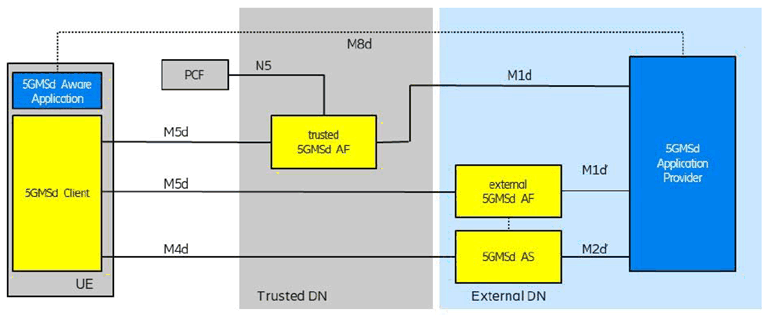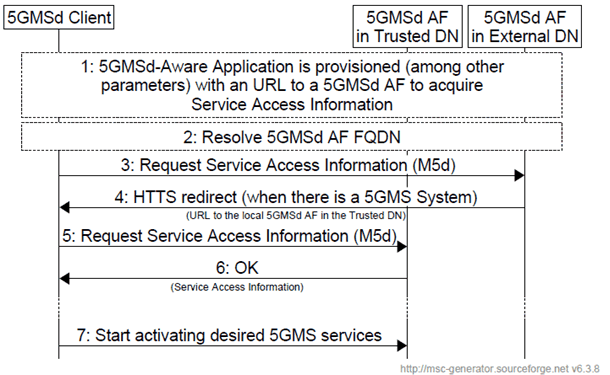Content for TS 26.501 Word version: 18.0.0
1…
4…
4.2…
4.2.2…
4.3…
4.5…
4.6…
4.7…
5…
5.2…
5.3…
5.3.2
5.4…
5.5…
5.5.3…
5.6…
5.7…
5.7.3
5.7.4…
5.8
5.9…
5.10…
5.10.5
5.10.6
5.11…
6…
6.2…
6.3…
6.5…
6.8…
7…
8…
8.2
A…
A.3…
A.5…
A.7…
A.9
A.10
A.11
A.12
A.13
A.14
A.15
B…
B.3
C…
C.3
C.4
C.5
D…
B.3 Deployment with HTTPS-based resolution p. 134
Figure B.3-1 depicts the deployment for HTTPS-based resolution of the 5GMSd AF in the Trusted DN of the MNO which is currently providing connectivity to the 5GMSd Client.

For the HTTPS-based resolution mechanism, the 5GMSd Client is provisioned with a Service Access Information URL, for example dynamically via M8d or statically within the code of the 5GMSd-Aware Application. The Service Access Information URL contains an FQDN of a 5GMSd AF within the 5GMSd Application Provider domain, which acts as a request redirector.

Steps:
Step 1.
The 5GMSd-Aware Application is provisioned (among other parameters) with a URL of the 5GMSd AF from which to aquire Service Access Information. The 5GMSd-Aware Application passes this URL to the 5GMSd Client upon start.
Step 2.
The 5GMSd Client uses DNS to resolve the FQDN of the URL.
Step 3.
The 5GMSd Client issues a request to the resolved 5GMSd AF in order to acquire the Service Access Information.
Step 4.
Based on information from the originating network (e.g. visible IP of the 5GMSd Client), the 5GMSd AF in the External DN creates an HTTPS redirection response. The 5GMSd AF looks up the according FQDN of the 5GMSd AF in the trusted DN and sends an HTTPS redirection response to the 5GMSd Client.
When the 5GMSd AF in the External DN does not offer 5GMS features, or if the 5GMS features are not provisioned it instead provides a response containing an HTTP error message.
Step 5.
The 5GMSd Client issues a request to the resolved 5GMSd AF in order to acquire the Service Access Information.
Step 6.
The 5GMSd AF provides the Service Access Information in its response to the 5GMSd Client. The Service Access Information contains URLs and parameters according to provisioned 5GMS features.
Step 7.
When needed, the 5GMSd Client uses the acquired Service Access Information to activate the needed 5GMSd feature(s).